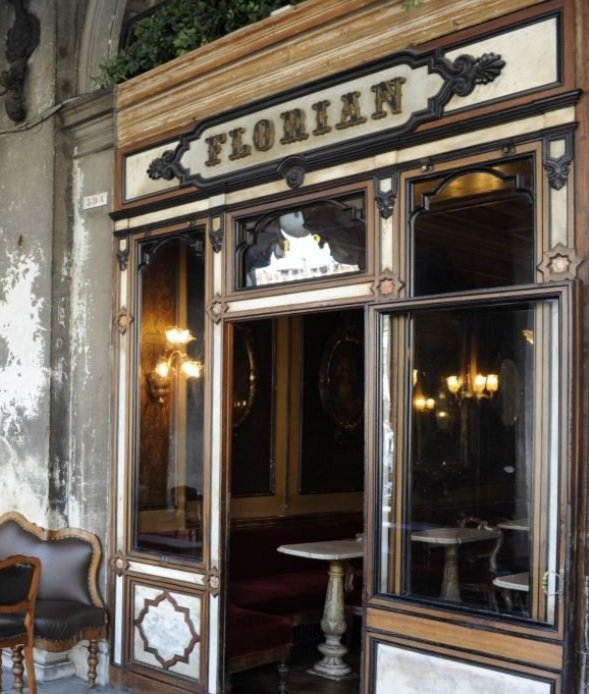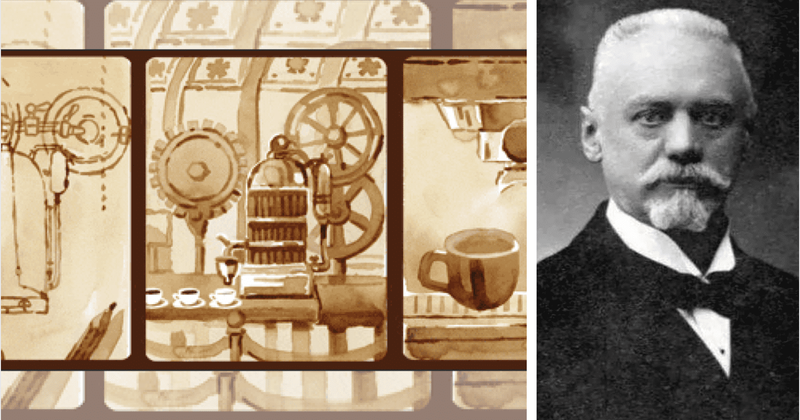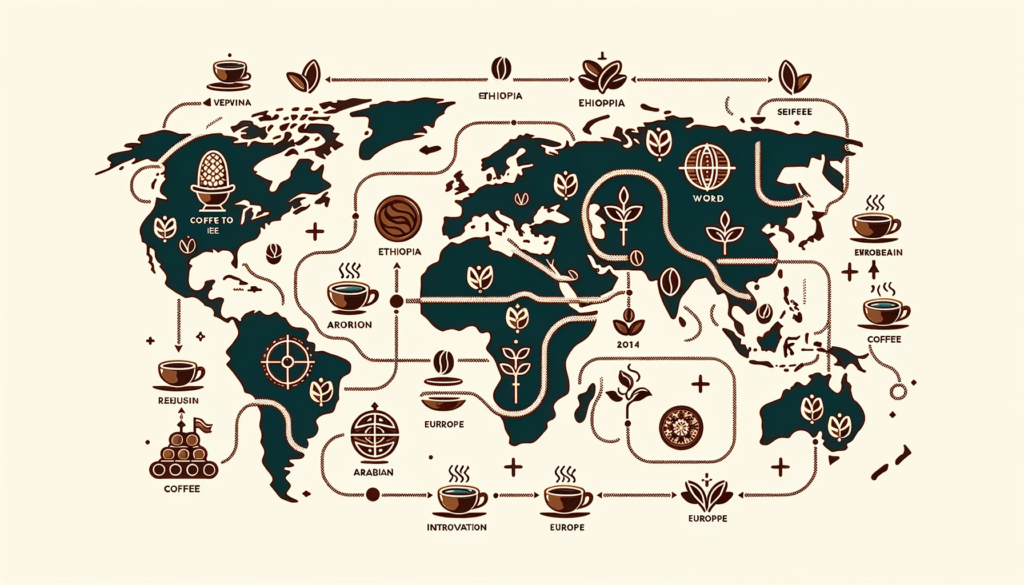Our favorite morning beverage choice has become so commonplace that it is difficult to imagine that this beverage has been around for thousands of years. I always wondered where and how it got started. The history of coffee dates back centuries and is rich with legends, cultural significance, and global trade.
(1000 B.C – A.D. 500)
1. Origins and Early Use
All my research points to the nomadic Oromos tribe in the Kingdom of Kefa (modern-day Ethiopia) who first discovered coffee. They are also called The Galla. You will be surprised that they did not use it as a beverage but in fact, ate it – crushed the beans, mixed it with fat making small meatball-like portions.
They used it as an energy charge during their battle with the Bonga tribe. Unfortunately, the caffeine boost was not enough to win the battle and the Oromo tribe were soon traded as slaves.

However, people still debate these exact origins and the history of coffee. According to popular legend, a goat herder named Kaldi noticed that his goats became more energetic after eating berries from a certain tree. Curious, he tried the berries himself and experienced a similar boost in energy. Kaldi shared his discovery with a local monk, who used the berries to create a drink that helped him stay awake during long hours of prayer. Another legend has it that a Sufi mystic could talk with the energized birds who had nibbled on those cherries, urging him to try those berries for himself.
These legends do capture our imagination though. However it is certain that this early form of coffee consumption likely dates back to the 8th century.
(600 A.D. – 1400s)
2. Spread to the Arabian Peninsula
Coffee’s popularity grew, the history of coffee getting richer and by the 14th century, it had spread to the Arabian Peninsula. In Yemen, the drink was called “qahwa,” and it gained cultural and social significance as a beverage that facilitated conversation, intellectual discussion, and social gatherings. Coffee houses, known as “qahveh khaneh,” became important centers of social interaction and learning. By the 15th century, coffee’s popularity began to rise significantly in Yemen, particularly in the port city of Mocha. The city’s strategic location as a trade center allowed coffee to spread beyond Yemen’s borders. In Yemen, coffee had religious significance as well. Sufi mystics, who often engaged in extended prayer and meditation sessions, used coffee to help them stay awake during their rituals.

(1500-1700s)
3. Coffee’s Journey to Europe
Coffee’s fame continued to grow, and by the 16th century, it had reached Europe. Calling it the bitter invention of Satan, Pope Clement VIII initially rejected (though controversial per historians) the favorite drink of Turks. According to the popular tale, around the year 1600, Pope was presented with coffee by his advisors, who wanted his opinion about the beverage. Though he liked it, Pope was concerned about its stimulant properties and only allowed the drink to be consumed in moderation.
The first coffeehouse in Venice, Italy, is believed to have opened around 1720, marking a significant milestone in the introduction of coffee to Europe. This establishment was known as “Caffè Florian,” and it is still in operation today.

Coffee houses emerged in cities like Venice, London, and Paris, becoming hubs for intellectual exchange, political discussion, and social interaction. The introduction of coffee to Europe marked the beginning of coffee’s global spread.
(1700- 1800s)
4. Colonial Expansion and Coffee Plantations
By 1658, the Dutch entrepreneurs were growing coffee in Ceylon & their East Indian colony of Java. European colonial powers saw the economic potential of coffee and established plantations in various tropical regions, including the Caribbean, Central and South America, Southeast Asia, and Africa. In the late 17th century, coffee was introduced to French Guiana and the Caribbean islands. However, it was in the early 18th century that coffee cultivation gained prominence in the colonies of Central and South America, including countries like Brazil, Colombia, and the Caribbean nations.
The colonial expansion of coffee led to the establishment of extensive trade networks that connected coffee-producing colonies with coffee-consuming markets in Europe. One of the key figures in the colonial expansion of coffee was Gabriel Mathieu de Clieu. A French naval officer, de Clieu is renowned for successfully transporting a coffee plant from Paris to the Caribbean colony of Martinique in 1723. Despite challenges including storms and a lack of water, de Clieu nurtured the plant, establishing coffee cultivation in the Caribbean. This article accounts for fascinating details about this naval office.
This expansion led to the widespread cultivation of coffee in these regions and significantly shaped the global trade and coffee history.
Great article with more details here

5. Industrialization and Modernization
The 19th century saw advancements in coffee preparation, including the invention of the espresso machine. This in a way changes the course of the history of coffee to follow. This innovation led to the creation of new coffee beverages, such as espresso and cappuccino. As transportation and communication improved, the coffee trade became more globalized, with various coffee-producing regions specializing in different types of coffee beans.

(1900+)
6. Coffee and the New World
Coffee was introduced to the New World during the colonial period. It became a major cash crop in countries like Brazil, which has since become one of the largest coffee producers in the world. The growth of coffee plantations often had profound social and economic implications, including issues related to labor and land ownership. Different parts of the world consume coffee in unique ways.
In 1962, the International Coffee Agreement was established to stabilize coffee prices and ensure fair trade practices among producing and consuming countries. Of course, the history of coffee would be incomplete without the emergence of Starbucks. This global coffeehouse chain alone has a market capitalization of ~$100 billion.

(2000s)
Coffee has evolved into one of the world’s most popular beverages, with a diverse range of brewing methods, preparation techniques, and regional variations. In the United States alone, there are about ~39,000 coffee shops! Coffee ranks second only to petroleum in terms of dollars traded worldwide. It remains an integral part of many cultures and societies, and its economic significance continues to shape the livelihoods of millions of people involved in coffee cultivation, processing, and trade. In recent years, the global coffee trade has generally been estimated to be around $20 to USD 30 billion annually. Coffee and Caffeine have been the subject of extensive scientific study with over 2000 papers published annually.
The history of coffee is a fascinating journey that intertwines with cultural practices, trade routes, technological advancements, and global connections. It has left an indelible mark on societies around the world and continues to be enjoyed by people from all walks of life.
References:
https://static.scientificamerican.com/sciam/assets/File/kefatocafelarge.jpg
http://www.historyofcoffee.net/coffee-history/timeline-of-coffee/
https://www.jstor.org/stable/3629113
https://www.pbs.org/food/the-history-kitchen/history-coffee/
https://www.scientificamerican.com/article/the-science-of-a-perfect-cup-of-coffee/
https://www.nescafe.com/in/understanding-coffee/coffee-history

